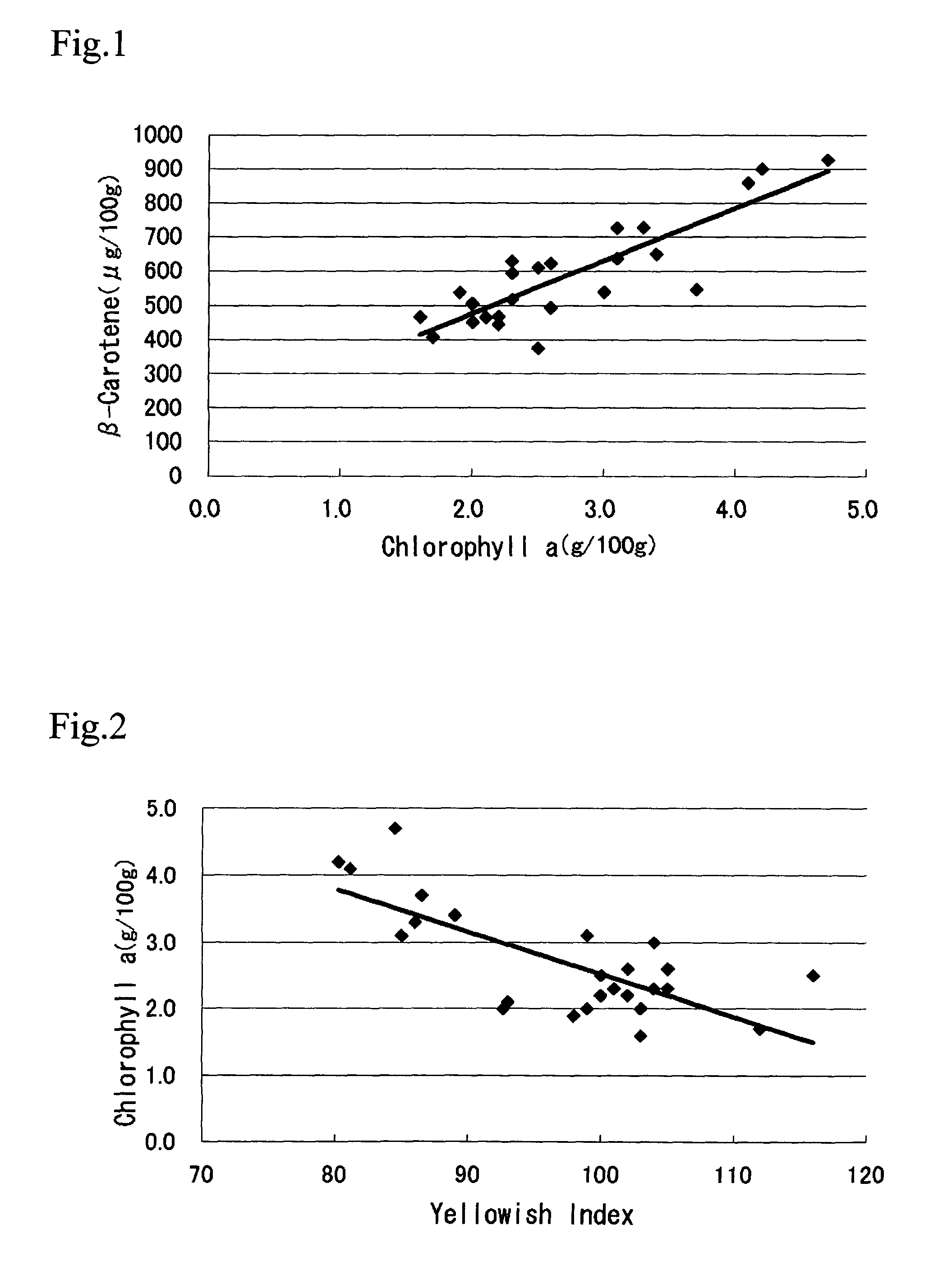Green soybeans whose color is prevented from discoloring
a technology of green soybeans and soybeans, which is applied in the field of green soybeans, can solve the problems of unstable chlorophyll content in green soybeans, affecting the color of green soybeans, and reducing the commodity value of cooked green vegetables, so as to prevent the color from discoloring, the effect of green color and suppressing the decomposition of chlorophyll
- Summary
- Abstract
- Description
- Claims
- Application Information
AI Technical Summary
Benefits of technology
Problems solved by technology
Method used
Image
Examples
example 1
(Tests on Suppression of Discoloration of Green Soybean)
[0053]A test for suppressing discoloration of a green color was made by immersing green soybeans in aqueous solutions of various anti-oxidation materials, such as ascorbic acid, tocopherol and carotenoids, thus causing the anti-oxidation materials to permeate into tissues under depressurization and to capture radicals inducing decomposition of chlorophyll. However, the effect of those anti-oxidation materials was hardly confirmed.
[0054]Next, to check the effect resulting when anti-oxidation materials permeated into tissues, particularly chloroplasts, of a living body, a test for suppressing discoloration of a green color was made by preparing a chlorophyll / ethanol solution including chlorophyll, dissolving each of various anti-oxidation materials in the solution, and preserving it under illumination of light. More specifically, 4 ml of the chlorophyll / ethanol solution was prepared by adding 25 μg of chlorophyll in 1 ml of ethan...
example 2
(Effect of Retaining Green Color of Green Soybean Depending on Cultivating Conditions)
[0057]To obtain the effect of planting density, the cultivating condition regarding a root interval for green soybeans was enlarged from an conventional interval of 6 to 8 cm to an interval of 11 to 13 cm. More specifically, a sort of green soybean called “ryokkou (green light)” was employed and cultivated in two groups, i.e., one in which the root interval was set to the range of 6 to 8 cm (control group) and the other in which the root interval was set to the range of 11 to 13 cm (inventive group). The planting density was 2860 roots / 10a in the control group and 1820 roots / 10a in the inventive group. The content of β-carotene, the content of chlorophyll a, the yellowish index, and the shelf life of pods of the green soybeans cultivated under the above-described conditions were measured. The content of β-carotene was measured in accordance with the method stated in “Explanation of Food Standard Co...
example 3
(Effect of Retaining Green Color of Green Soybean Depending on Fertilizing Conditions)
[0061]In a similar way to that in Example 2, the tests were conducted except for setting the NPK ratio=5:20:15 kg / 10a (control group) and the NPK ratio=17:6.5:22 kg / 10a (inventive group) in the fertilization control. Measured results are shown in Table 3 given below.
[0062]
TABLE 3Content ofContent ofβ-carotenechlorophyllYellowishShelf(μg / 100 ga (g / 100 gindex oflifewet weight)wet weight)pod(hour)Control group5402.210213Inventive group9274.77830
[0063]As a result, in the inventive group, green soybeans containing a larger amount of β-carotene and having a deeper green color which is prevented from discoloring were obtained. This result is presumably attributable to the reason as follows. An increase of iron in tissues induces intermediate metabolic materials for biosynthesis of chlorophyll and therefore the biosynthesis of chlorophyll is activated so as to promote accumulation of β-carotene. About 4% o...
PUM
 Login to View More
Login to View More Abstract
Description
Claims
Application Information
 Login to View More
Login to View More - R&D
- Intellectual Property
- Life Sciences
- Materials
- Tech Scout
- Unparalleled Data Quality
- Higher Quality Content
- 60% Fewer Hallucinations
Browse by: Latest US Patents, China's latest patents, Technical Efficacy Thesaurus, Application Domain, Technology Topic, Popular Technical Reports.
© 2025 PatSnap. All rights reserved.Legal|Privacy policy|Modern Slavery Act Transparency Statement|Sitemap|About US| Contact US: help@patsnap.com



